by Kate | Feb 26, 2013
It’s true, I have a pocket patella, which I will tell you about in due time. First, let me explain a bit about how our M1 class has evolved throughout our year in the anatomy laboratories.
The thing is, I still secretly love anatomy lab. Sure, it can be long and cold and smelly and tiring, but we also have a lot of fun in there. I am lucky, of course, to have two amazing teammates to dissect with. The three of us have fallen comfortably into our roles and we have a solid division of labor…that leaves time for exchanging good jokes and our weekend stories. We teach each other, we get excited, and we enjoy soliciting the professors’ stories of medicine “back in the day.”
However, we have gotten to that time of year when students are not always as enthusiastic about anatomy as we were at the beginning. In all fairness, much of the actual dissection is analogous to the “manual labor” stage and you can’t learn all the details while in lab; you still have to study from books and online modules before and after dissecting. Much of the time spent in there with the cadavers is the grunt work of removing layers and layers of fat and fascia before you can get to the interesting arteries and nerves. It’s like cleaning, and it takes several hours before you begin to find the structures that you are supposed to identify.
I’ll be honest: I genuinely enjoy the tactile experience of dissection. I like the textures, I like using my hands, and I like that it weirdly reminds me of cooking. There are occasional moments when I lose my emotional distance and dislike the feeling of cutting and violating places such as the face or the genitals, but mostly I find it fascinating and beautiful. Interestingly, it’s not the “classic” moments that touch me most deeply (although I admit that the first time I held a heart was a special moment). There are certain things I find beyond incredible for some inexplicable reason. The patella is one of those things.

Patellas (aka kneecaps) are the largest sesamoid bones in the body. Sesamoid bones are embedded in tendon and, in the case of the patella, they are also inside the joint capsule of the knee and closely related to the five ligaments, two menisci, and up to thirteen bursae. Anyhow, more to the point, the knee dissection was optional, but I got overly excited. Not only did I clean out the joint capsule, but I spent nearly 90 minutes carefully, painstakingly removing every scrap of tissue from the patella. I really like patellas. They are beautiful and fit perfectly in your palm. My friend and classmate found a rock in the dog park that was exactly the shape of a patella; she picked it up, cleaned it, and made me a lucky pocket patella! It was her husband, another classmate, who taught me how to tell a right patella from a left one if you are holding the bone in your palm (they are slightly asymmetrical and when you place it with the curved side down it will fall to one side). Most importantly, my pocket patella has brought me great luck over the last several months. Embrace what you love, however eccentric. M1 year continues!
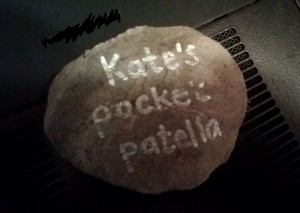
by Kate | Jan 7, 2013
Time flies when you’re having fun! Well, or when you are studying a lot and also having some fun in between libraries. It’s amazing how busy and settled I feel after just one term. During the Cardiovascular/Respiratory sequence, I made the gradual transition to “becoming a full-time streamer,” meaning that now I watch most of the lectures after they have been recorded on video. This gives me more flexibility in terms of when I study; plus, I find that I actually focus better when watching the lecture on my own. Coming from a small college, I’d always thought of myself as a “going-to-class-unless-on-the-verge-of-death” type of person, but that was partly because most of my classes were small and discussion-based. Here in medical school, I still very much enjoy the small groups, where we talk through problem sets or longitudinal cases, but I’ve found that I learn the material presented in the larger lectures just as well when outside of class. I am on the medical campus most days, for various groups, labs, meetings, and required events, but I spend a lot of time studying at Sweetwaters Coffee & Tea and at the Law library.
Despite the huge volume of information that must be learned each week, we manage to have time for a few other things in our lives. Each medical student finds a different balance, of course, but some of the things I most enjoyed this fall were tutoring at a high school, continuing research with my group in Switzerland, taking long runs through the Arb, and dancing in the winter Biorhythms show. “Biorhythms” is an incredible event put on entirely by medical students, from the choreography to the lighting to the performing. We had a blast!
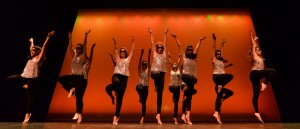

At the beginning of December, ready for some cheerful reminders during finals, I decorated my house for Christmas, including evergreen garlands around the bannister, poinsettias, ornaments, and more. It was just starting to snow when I left Ann Arbor for the holidays, but hadn’t yet gotten bitterly cold. Home in California, I enjoyed a few beautiful sunny days . . . and then I was positively delighted by the thick frosting of snow when I got back to Michigan! Below is a picture of a friend waving out the second story window of the medical school fraternity and a second picture taken from outside my front door. Happy New Year!
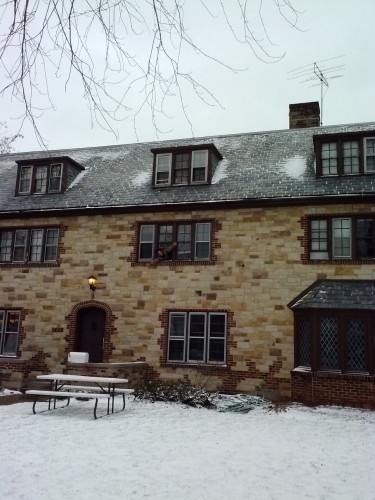

by Kate | Oct 7, 2012
There is absolutely nothing better than an entire week with patients. After an intense month of biochemistry, I was more than happy to be at hospitals and clinics, even if it meant getting up very early and being dressed semi-professionally. Now, for the first time, my white coat actually merits a good wash (I swear it’s not just me being me and wanting it to be extra clean and extra white…it really, really has some stuff on it that is – ahem – not dinner table conversation). The week-long mini-course, “Clinical Foundations of Medicine,” was a break from the routine for first-year medical students. We still had lecture, but it was on all of my favorite things: health care economics, law and policy, doctor-patient relationships, alternative medicine, and epidemiology.
I could tell you one hundred anecdotes from the various sites I visited, but I will stick with the highlights from each. At the HIV/AIDS Resource Center (HARC), I was struck by how differently I saw things after talking with the employees. Though I’d read all of the statistics before, it is very different to watch clients walking in and to talk with the manager about the percentages of people who are of color, who are men, who are homosexual or who are homeless. I was also somewhat sad, though not surprised, to learn about how limited HARC’s outreach and education efforts are at the middle- and high school level. It turns out that these limitations stem from the state’s public education funding that has abstinence-based sex-ed. On the other hand, HARC apparently does a great job in Ann Arbor with their outreach events at Aut Bar and Necto.

Moving on to my “senior visit” at an assisted living facility, I was delighted with the ninety-five-year old woman I interviewed. Seeing as my grandparents are some of my favorite people in the entire world, it’s no shocker that I loved every minute of my conversation with this fiery, opinionated old woman. She repeated a few of her stories, but was generally quite sharp and even witty. She did phenomenal imitations of the other senior citizens in the home, cupping her hand to her ear and pretending to be more deaf than she was and going on and on about how inane she found bingo. Sometimes I could barely keep up with her mockery and sarcasm. After a few questions about her medical history, it became clear she would much prefer to talk about her farming family and her political opinions. I’m not sure I want to go into geriatrics, but when you spend enough time with the lucid elderly, you realize that they are fascinating people who crave substantive conversation. I was particularly fortunate this week to talk to a senior who was from Finland, who had dated ski-jumpers, who ironed her brothers’ pants before they “went girling,” who called her husband her “helpmate,” and who referred to political debates as “simply horseshit.”
Besides the joy of hearing stories from another century, there is the simple truth that senior citizens are older and wiser. There is meaning behind their words when they tell you that the secret to life is finding the joke in anything serious. At various points in the conversation, she expressed this in different ways:
“Don’t let the little things get you down.”
“Most problems don’t amount to a hill of beans.”
“Laugh and the world laughs with you…cry and you cry alone.”
“Enjoy life. Go out and make it interesting. Don’t sit around waiting.”
I found myself thinking about a book I just finished, Expecting Adam, which is written by an ex-Harvard professor about her experiences while pregnant with a son who would have Down syndrome. In the epilogue, Martha Beck describes her son’s incredible ability to find humor in the most difficult of situations.
“There are many times when I see the pain on his face as he struggles to communicate…but just at that moment when Adam’s frustration is most intense and I expect to see him fall into rage or despair…he’ll take a deep breath, as though he is letting the frustration slide off his shoulders, and begin to laugh. This is not the laughter of an idiot. It is the laughter of a person who chooses to see humor in his own discouragement, and to me it is not only intelligent but wise.”

Humor, it turns out, is a raging epidemic in many clinical specialties. Perhaps this is doctors’ way of dealing with the pain and suffering that is surrounding them throughout the day. Sometimes, it can seem a bit crass and inappropriate, but most of the time the patients appreciate it, too. In otolaryngology (ear, nose, and throat) I saw many patients who were greeted like old friends by their physician. There were jokes about how the doc loved smokin’ too but decided he’d rather not get cancer, there were those who referred to local anesthetic as “Canadian local” and then proceeded to talk about their favorite liquor, and there were imitations of prissy female doctors in other not-to-be-named specialties.
The final clinic I went to was with an allopathic doctor (MD) who used to work at UM and now has a private practice in partnership with an osteopathic doctor (DO). I could go on forever about how much I enjoyed her office. As I entered the clinic with my medical student partner, we turned to each other and whispered that our living rooms were not as well decorated as their exam rooms. There were the standard tables and beds, but also comfortable chairs, stenciled quotations, and peaceful paintings. I’d been eager to see how this particular physician integrated her knowledge of standard allopathic medicine with complementary and alternative practices. The immediate and obvious difference is in the time spent with patients; during my two hours at the medical center, I spent half an hour talking to the doctor about her approach, 75 minutes with one patient, and then 15 minutes debriefing. The clinical appointment was an intake evaluation and was thus particularly long, but 75 minutes is not unheard of. The focus is on knowing the patient as a complete person and listening to their full story. The particular women we saw was clearly someone with a complex assortment of complaints that were related to both her physical and psychological state. Knowing the intense anxiety and sadness that was present in her personal life helped explained some of the physical manifestations. The patient felt she was being taken care of and she respected the doctor’s time; she had come with a list of specific questions and had done quite a bit of research on her own. She was well-educated and knew how to do some research into conditions on her own, but was still willing to listen to the doctor’s evaluation.
There was also extensive opportunity for “reading between the lines.” As we got to know the patient better, it was clear how much she was struggling and it was increasingly evident when she was holding back information. For instance, when asked about her drinking habits, she answered quickly and then abruptly changed the subject. When talking about this part of the appointment in private after the patient had left, the doc explained that she had ordered liver enzyme analysis in the labs she wrote up and that she wanted to wait to press the issue further until she had established trust with the patient.
I was blown away by the comprehensive nature of the physical examination. The doctor even did a few basic manipulations often performed by physical therapists in order to re-align the woman’s hips. Interestingly, there are many “chiropractic” maneuvers that are considered mainstream if done by a physical therapist. This dichotomy also exists – to a certain extent – with the use of heat ultrasound for injury treatment. At this medical center, they address a range of physical, emotional, and neurological problems in patients of all ages. I think what most impressed me was their openness to using either “standard” or “alternative” techniques depending on the individual patient and what would work for their particular needs and lifestyle. They use everything from x-rays and blood tests to massage and psychotherapy to bioenergetics and homeopathy. I came away with incredible respect for their ability to straddle the allopathic and osteopathic worlds.
What a week! I should now go pack up my dry-cleaning and get ready for tomorrow: a normal Monday back in jeans in the lecture hall.
by Kate | Sep 24, 2012
So much has happened since I moved to Ann Arbor that it would be silly to try to go back too far. A few highlights of the weeks before medical school included building my own furniture, traveling to visit family in Maine, and inviting other incoming med students over for wine and cheese on my deck.
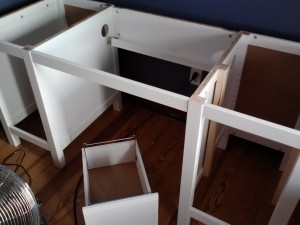
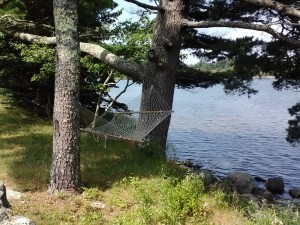
Since then, two very important things have started: anatomy lab and football season. The former is a lot of time with lots of cadavers and the latter is a lot of time with a lot of Maize. So, here we go.
Anatomy lab is enjoyable but intense. Few people are actually squeamish or resistant to the idea, but dissections are long, tiring, cold, and smelly. Fortunately for my group, we have a particularly interesting cadaver. From the outset, even before we (actually, I!) made the first cut into the back, we noticed a tube sticking out. At first we thought it was part of the embalming process, but soon discovered it went deep down, becoming what we think is a pleural drain for lung fluid.
I’ll be honest: the worst part of any dissection is the skinning process. Some people say you are “lucky” if you get an old woman who died of cancer because then she will be very thin, with little fat to remove, and have osteoporotic bones that are easy to break into. I know it sounds morbid, but the facts are accurate. During the dissection of the vertebrae and spinal cord, we actually had to chisel into the spine and…well…sometimes the force of the blows causes fatty tissue or bodily fluid to spray up onto you.
Last week, for the first time, we turned our cadaver onto her back to do a chest dissection. Low and behold, the right breast did not have a nipple, so we knew right away something was going on. As our team went carefully in, we cut out a breast implant — an old school one that was a plastic sack filled with yellow saline solution (no, none of your new, fancy silicon to be had here). Going deeper, we found that she had an enormous blood clot (think really, really big, like a gold ball) next to the implant; perhaps the clot had formed during the mastectomy. In all likelihood, she had breast cancer, as the pectoral muscle under the right breast was also missing, something the surgeon might have removed for fear of metastasis. As if that wasn’t enough, the dissection of the left side revealed a pacemaker in the heart and, finally, sternal staples in the center of her rib cage from open-heart surgery. Who knows what else we’ll find? It’s still only September.
(Sorry, no pictures of cadavers in anatomy lab. It would be disrespectful to the anatomical donations.)
Football, of course, has also started. Coming from a small, liberal arts college and from a family who doesn’t follow sports, the world of the Big 10 is exciting and terrifying to me. I didn’t realize how much I loved the whole scene until I found that before football games I actually start to feel like I used to before my own college cross country races: nervous, excited, energized, and completely unable to focus on school work. I still have no ability to follow every play of every game, but I enjoy the entire production so much it’s hard to resist.
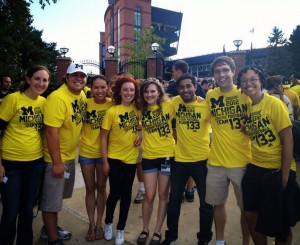
The medical school students have a section that we all sit in, near the north end zone. I didn’t buy season tickets, so for the first two home games I have bought them from other med students who weren’t going to that particular game. The first week was great, since I took my weekly quiz Saturday morning, went briefly to pre-game happenings, enjoyed the whole game, and then went to Sava’s for dinner. The next week was equally great before the game: a quick morning run, some studying on my deck, and two different tailgates. By mid-way through this second game, I was starting to catch on to the cheers and songs, especially when standing with my friend who had been in the marching band as an undergrad here.
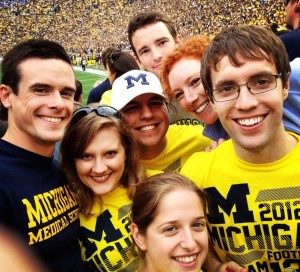
In other completely unrelated news, I had a dream that one of my feet had four toes and the other had six. I am not sure if this idea came from the fact that I have huge blisters from running (that sometimes seem as big as toes) or from the fact that we have been studying planned apoptosis in human development (such as when the webbing between fingers and toes in the human embryo undergoes programmed cell death). Who knows? I’m just curious about whether dreams about digit numbers signify something important.
On that note, I will leave you to enjoy your Monday while I go back to reading powerpoint slides from recent lectures. Until next time!
by Kate | Sep 14, 2012
It is important to have hobbies outside of medical school or you might go mad. Fortunately, the work/life (or, well, study/life) balance is something that Ann Arbor seems to foster. Even the smartest and most serious students have activities that do not involve the library or the hospital. Sure, there are a few that seem to have caught the “med student disease” and always appear rather stressed and harried, but at Michigan sightings of that susceptible breed are few and far between. Watch out, though, since there will always be someone who studies longer than you, someone who publishes more papers than you, someone who knows more professors than you, someone who got more grants than you, and someone who got their Nobel Prize before you.
I don’t care that this whole work-life balance is something that is incessantly talked about and blogged about. It really never gets old because it never gets solved. Yes, fine, you can make some general progress. You can go after certain things; you can relax certain standards. No matter what, though, the life of a student (or anyone, for that matter) is not one that can be governed by black-and-white rules. You don’t have to always go to Happy Hour or never go to Happy Hour. You don’t have to always study on Saturday or never study on Saturday. You don’t have to always take notes or never take notes. It sounds silly, but applying this principle to more complicated issues can get tricky. How much time “should” I spend with friends? When am I going to practice music or language? How much effort do I put into correspondence with family? Why should I actually sleep eight hours some nights? How many days can I fit in a run? Do I get to keep reading so many random novels? What does it mean to achieve a “balanced” life?
It means sometimes we play cards.

It means I go to the farmers market and then cook real food in my amazing kitchen.
It means we get to go hiking outside Ann Arbor on the weekends.
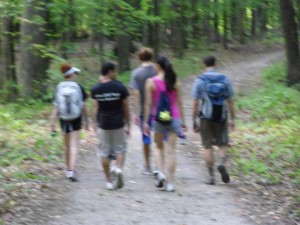
Obviously no one has a perfect answer to any of these questions about balance, though. These are the kinds of things you have to ask yourself every single day. Sometimes even when you take the time to do something, you are not exactly sure of your motivation. A recent bicycle tune-up experience comes to mind. Did I really need a trip to the bike garage? Maybe not. Was it still enjoyable and marginally productive? Absolutely.
Bike guy: We’ve had a lot of students this month, but the semester hasn’t started.
Me: Maybe they were also medical students, since we don’t follow university semesters.
Bike guy: Oh, are you a medical student? So you will be the Class of 2015?
Me: Well, med school is four years.
Bike guy: So Class of 2016?
Me: Ummmm, the thing is, actually…nevermind. Anyways, advice on where to ride? I know there is a bike trail that goes through Gallup Park, but I haven’t figure out how to get near there by road on a bike.
Bike guy: How do you know Gallup?
Me: Well, when I run through the Arb, I cut across the train tracks where it says “No Trespassing” and I always end up on the bike trail.
Bike guy: And you don’t want a kickstand?
Me: [look of repulsion and lack of interest at dorky accessory like kickstand]
Bike guy: [trying to decide if I am snobby or impractical or both]
Me: [awkward shifting of eyes and feet]
Bike guy: Do you swim too?
Me: Sort of. I used to. Kind of.
Bike guy: So you need a bike that would work for your future triathlons.
Me: Oh?














